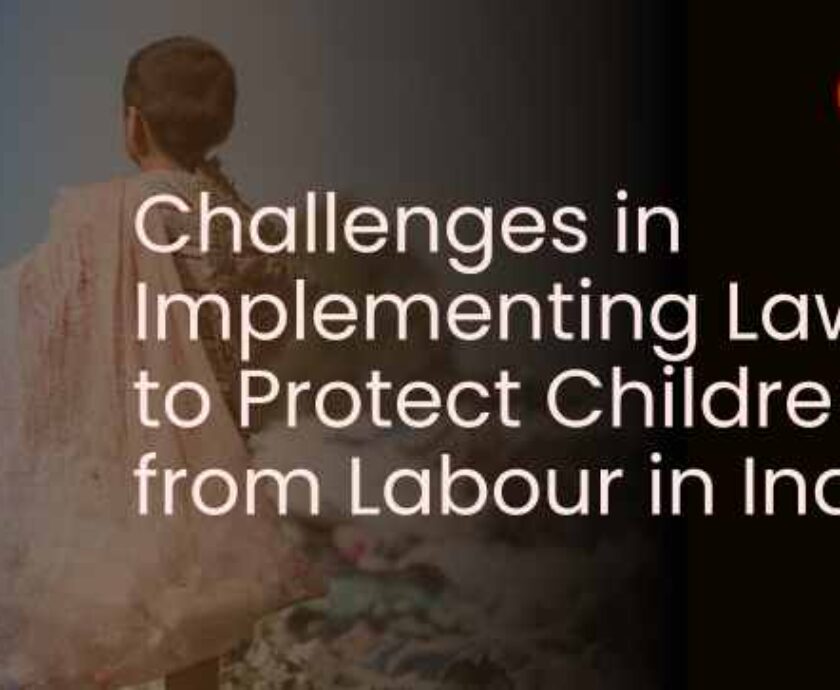Challenges in Implementing Laws to Protect Children from Labour in India

Child labour is a grave issue that has plagued India for decades. Despite laws and regulations, implementing measures to protect children from labour remains a significant challenge in the country. This article explores the obstacles faced in effectively enforcing child labour laws in India and suggests possible solutions.
Historical Context
Child labour has deep roots in India’s history, where socio-economic factors, poverty, and lack of education contribute to the perpetuation of this problem. The British Raj had exploited child labour during the colonial era, and the practice continued even after India gained independence. Recognising the urgency to address this issue, the Indian government introduced several laws and regulations over the years.
Legal Framework
India has a comprehensive legal framework to combat child labour. The primary legislation is the Child Labour (Prohibition and Regulation) Act 1986, which prohibits the employment of children under 14 in hazardous occupations and processes. The Act also establishes penalties for violations. Additionally, the Right of Children to Free and Compulsory Education (RTE) Act, 2009, guarantees free and compulsory education for children between 6 and 14.
Challenges in Implementation
Poverty and Lack of Awareness
Poverty remains one of the leading causes of child labour in India. Many families living in poverty see child labour as a means to supplement their income. Moreover, a lack of awareness about the consequences of child labour perpetuates its prevalence. Efforts must be made to address poverty through targeted social welfare programs, along with awareness campaigns to educate communities about the importance of education and the hazards of child labour.
Inadequate Enforcement Mechanisms
One significant challenge lies in the inadequate enforcement mechanisms of child labour laws. Insufficient staffing and resources hinder the effective monitoring of workplaces, making it easier for employers to employ children without detection. Strengthening enforcement agencies and providing them with the necessary resources, such as additional personnel and modern surveillance technology, can enhance their capacity to detect and prevent child labour.
Complex Supply Chains
The globalized nature of supply chains presents another obstacle to combating child labour. Many industries in India are part of international supply chains, making it difficult to trace the origin of products and identify instances of child labour. Implementing robust supply chain management systems that promote transparency and accountability can help identify and eliminate child labour practices.
Lack of Rehabilitation and Social Support
While rescuing children from labour is essential, their rehabilitation and reintegration into society are equally crucial. Many rescued children face psychological trauma and require adequate support, including counselling, education, and skill training. However, the lack of rehabilitation facilities and social support systems makes providing comprehensive assistance to these children challenging. Strengthening rehabilitation programs and partnering with non-governmental organizations can address this issue.
Corruption and Bribery
Corruption and bribery pose significant challenges to effectively implementing child labour laws. Unscrupulous employers often bribe officials to overlook their violations, allowing child labour to persist unchecked. Tackling corruption requires strict disciplinary action against officials involved in bribery and the promotion of transparency in the implementation of laws.
Solutions and the Way Forward
Strengthening Education
Quality education is crucial for breaking the cycle of poverty and child labour. Enhancing access to education, particularly in marginalised communities, and improving the quality of schools can motivate children to attend school rather than engage in labour. This can be achieved by expanding school infrastructure, recruiting well-trained teachers, and providing scholarships and incentives to encourage enrollment.
Empowering Communities
Engaging and empowering communities is vital for combating child labour. Community-based organizations can play a significant role in raising awareness about the harms of child labour and promoting education. By involving community leaders, parents, and local stakeholders, a collective effort can be made to address the root causes of child labour and create a supportive environment for children’s education.
Strengthening Enforcement
Efforts must be made to strengthen enforcement mechanisms to effectively implement child labour laws. This includes increasing the number of labour inspectors, improving their training, and providing them with the necessary tools and resources to conduct inspections. Strict penalties and legal consequences for violators should be enforced to deter employers from employing children.
Collabouration with Businesses
Collabouration with businesses is essential to eradicate child labour from supply chains. Companies should implement robust social compliance programs, conducting regular audits and inspections to ensure that child labour is not employed in their operations. Additionally, promoting responsible sourcing and supporting suppliers that adhere to ethical labour practices can create a domino effect in the industry, encouraging others to follow suit.
Rehabilitation and Support
Efforts to rescue and rehabilitate children from labour should be accompanied by comprehensive support services. This includes providing access to quality healthcare, counseling, vocational training, and job placement assistance. Collabourating with NGOs and civil society organizations that specialize in child welfare can strengthen the rehabilitation process and ensure that rescued children have the opportunity to rebuild their lives.
Strengthening International Cooperation
Child labour is a global issue that requires international cooperation. India should collabourate with other countries, international organizations, and non-governmental entities to share best practices, exchange information, and develop joint initiatives to combat child labour. This cooperation can involve knowledge-sharing, capacity-building, and financial support to strengthen India’s efforts in protecting children from exploitation.
Conclusion
While India has made significant progress in enacting legislation to protect children from labour, numerous challenges persist in implementing these laws effectively. Poverty, lack of awareness, inadequate enforcement mechanisms, complex supply chains, and corruption hinder the eradication of child labour. By addressing these challenges through education, community empowerment, enforcement, collaboration with businesses, rehabilitation, and international cooperation, India can take significant strides towards ensuring a brighter future for its children, free from the shackles of child labour. It is a collective responsibility to protect and nurture the innocence and potential of every child, for they are the foundation of a prosperous and just society.
About Poornseva Sansthan
Poornseva Sansthan is a dedicated NGO in India committed to eradicating child labour by promoting education and providing support to vulnerable children. With a firm belief in the transformative power of education, the organization works tirelessly to ensure that every child has access to quality education and a safe environment. By addressing the root causes of child labour and offering comprehensive support services, Poornseva Sansthan aims to break the cycle of poverty and empower children to build a brighter future. Through their unwavering dedication, they are playing a vital role in creating a society where every child’s rights are protected and their potential is nurtured.






